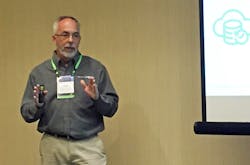Equipment Utilization and Monitoring From the Cloud
Though some customers are still hesitant to let applications escape their hold, cloud-based applications can offer a lot of benefits that on-premise applications cannot. Computing power is one key benefit—offering incredible scalability without the need to beef up on in-house servers.
That kind of computing power goes a long way for evaluating operational performance and overall equipment effectiveness (OEE), so to the cloud is exactly where Schneider Electric is going with its next manufacturing execution system (MES) launch.
“If we tell customers to buy more computing power, that doesn’t make sense,” said Tom Troy, director of Schneider Electric’s operations and execution portfolio. “We can do analytics in the cloud that they can’t do on-premise today.” Now Schneider Electric can start bringing intelligence to customers by providing insights that perhaps they weren’t even looking for, he added.
With the first release scheduled for November, Schneider Electric offered up a preview of MES for the cloud at the Innovation Summit: Software Conference 2017, going on this week in San Antonio, Texas. As Schneider Electric readies its launch, what it is specifically not doing is starting with its existing on-premise MES and taking it straight to the cloud, Troy said. “We’re starting with a clean sheet,” he said. “We want to embrace Microsoft Azure technology and do things in a different way. We’re going to deliver these modern applications that embrace Industry 4.0 concepts.”
What Schneider Electric just launched is called Insight Performance, the company’s first MES module in the cloud. And although the company is determined to take advantage of what is unique to the cloud, it’s not that the MES will be completely different, Troy emphasized. “It’s still going to do MES-like things. It’ll just do it in a different manner, with a different scope,” he said. “We’re just leveraging a different technology base to do it.”
Schneider Electric is taking advantage of cloud-based capabilities (Microsoft Azure, specifically, its “platform of choice,” Troy said) to provide and OEE/performance management application that is completely managed by Schneider Electric. “There’s nothing that you would have to stand up from a server perspective,” Troy added.
It will support automated and/or manual data collection. In its first release, it will support everything needed for an OEE solution. The second release, slated for a January launch timeframe, will leverage historian publisher technology.
Rapid application provisioning is a natural byproduct of the cloud environment. “This is the part I really love,” Troy said. “It makes it a simple onboarding and configuration process.”
On-premise edge computing will be optional for robust on-premise event store/forward capability and device/sensor connectivity. “Data coming out of the automation controller is usually not in the format we need, so requires pre-processing,” Troy said. “In the edge computing device, we’re thinking about a nice clean experience. For edge device and application management, we want that to happen from the cloud. Everything has to be managed from the cloud—that’s our goal.”
Advanced reporting and equipment monitoring is also part of the new offering. Advanced analysis and analytics is provided by Wonderware InSight and Wonderware SmartGlance. “You’re going to see the experience that we have today in Wonderware Online Insight,” Troy said. Today, however, users search for tags. Going forward, they’ll search instead for equipment or other assets. “But it’s the same experience that you see today with our historian.”
The first production release in November will be a downtime tracking application with the following capabilities:
- Standard downtime/utilization even data collection
- Equipment downtime/utilization monitoring capability for operations personnel
- Downtime/utilization even split, merge and reclassification
- Standard downtime/utilization dashboard
- Extended properties for downtime/utilization events (e.g., add context to downtime/utilization events)
The second production release in January will be a full OEE application, including all the downtime tracking features delivered in the first release along with:
- Standard production even data collection
- Equipment OEE monitoring capability for operations personnel
- Standard OEE dashboard
- On-premise downtime/utilization and production event data publisher
- Extended properties for production events (e.g., add context to production events)
One important point that Troy made during his presentation was the need to support different performance models “For some industries, it’s considered risky to have pure cloud-based applications,” he said. “We’re architecting and developing the solution so customers can mitigate risk as they see fit.”
The cloud platform, as Troy detailed, can deliver a “frictionless” experience with its app configuration, equipment monitoring and performance analysis activities. It delivers superior enterprise-level analytics while also reducing the total cost of ownership and the time to value. It compliments on-premise OEE/performance applications with value-add capability.

